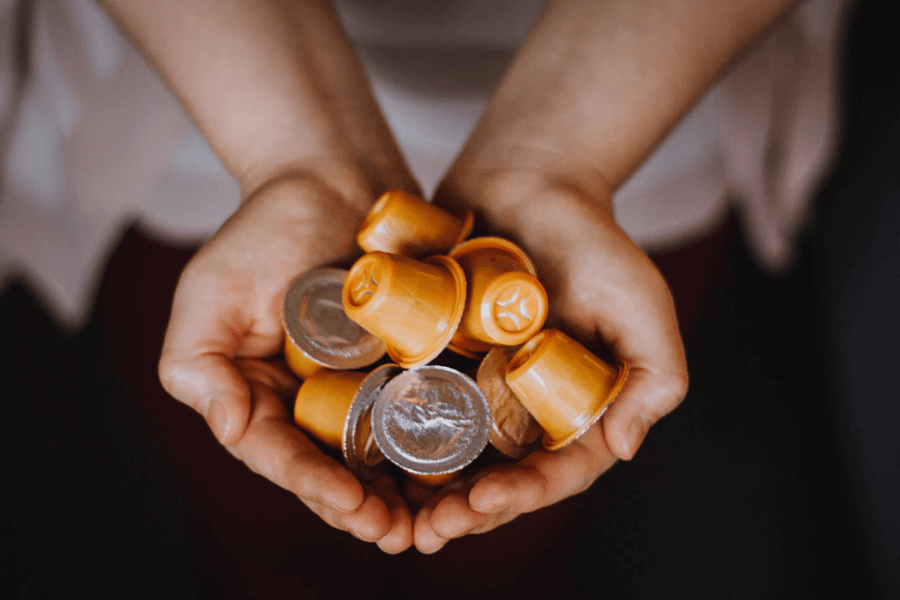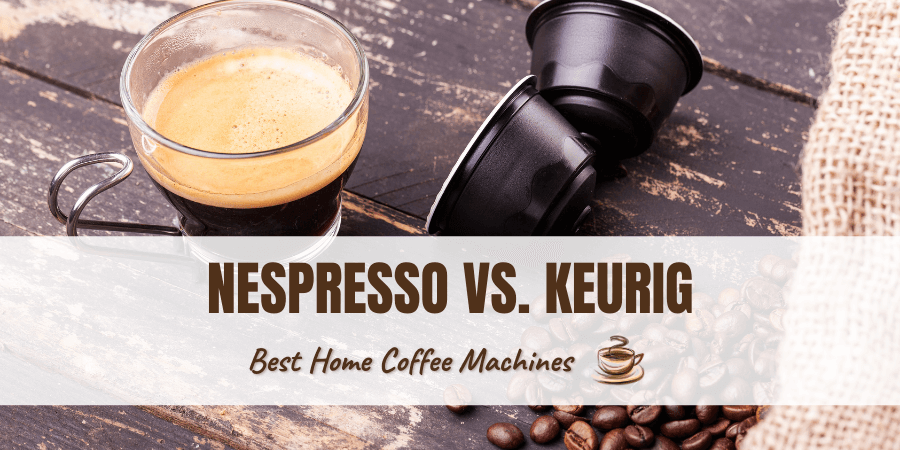Nespresso vs. Keurig: Which One Should You Pick?
Pod coffee machines are quite an anomaly; they offer consumers variety in terms of flavor and style but limit the product brands you can choose from. K-Cups won’t fit in capsule machines and vice versa.
To someone new to the pod game, the difference can be daunting.
I want to settle the Keurig vs. Nespresso debate once and for all. To do so, we’ll explore each manufacturer in-depth, here’s what’s coming up:
A History of Pod Coffee
According to the history books, Eric Favre, a Swiss engineer working for Nestle, invented pod coffee makers because standard filter coffee took too long to brew and it frustrated him. Inspired by Italian baristas who controlled pressure for faster brewing times, he set out to create simpler machines capable of the same process.
Hoping that his innovation would fill a gap in the commercial market, Favre spent the next ten years developing what became the first Nespresso (and pod) machine. Nestle pitched it to offices as an in-house instant espresso maker. The target market was disinterested and the initial pitch garnered no success.
Enter Jean-Paul Gaillard in 1988. Gaillard revamped Nespresso’s marketing to target homes instead of businesses and pushed Nespresso machines as a luxury household item — one that dispensed top-notch espresso. Consumers took the bait.
In no time, Nespresso spread throughout Europe but struggled to break into the US market and many Americans favored filtered coffee.
Until Keurig entered the ring in the 1990s, pod coffee was a fad few Americans paid attention to. And Keurig failed to make as much of an impact as Nespresso due to the company’s financial disadvantage. But even so, it was Nespresso’s first, and at the time only, competition, and it made waves. Small waves, but waves nonetheless.
To this day, these two manufacturers remain at the top of the pod coffee game, with Nespresso dominating and Keurig close behind.
Although the Pod War is a young one, it’s almost as old as pod coffee itself. The numbers show that Nespresso is more popular and always has been. But is it worthy of its reign, or is Keurig better?
Let’s find out.

Nespresso vs Keurig: Which Machine Is Better?
Both Keurig and Nespresso are formidable manufacturers that make excellent machines. Still, there are many aspects where each company’s machines are too different to overlook, and these variations could make or break which one is right for you.
Build and Design
It’s difficult to compare the quality, design, and features of Nespresso and Keurig machines because each individual model (on either side) is unique. For example, Nespresso’s higher-end machines have patented barcode recognition, while Keurig has a mini range that’s a godsend to those with less room.
Nespresso highlights luxury and therefore has more sophisticated technology. It also uses superior quality materials when compared to Keurig. It’s not to say that Keurig coffee makers are for cheapskates, rather that Nespresso machines, by default, are built with extra finesse.
Nespresso may be almost dull in its uniformity, but the neutrality of its designs makes them all the more stylish. A Nespresso machine fits into absolutely any kitchen — and while it’s a matter of personal preference, I feel that Nespresso’s sleek machines deserve the point here too.
Keurig almost took the point for variety. A quick search on its website shows 13 pod coffee machines currently available, while Nespresso only lists 10. However, Nespresso collaborated with other brands, which added dozens of machines to its catalog.
Brewing and Operation
It pains me to say this because Keurig really hasn’t done anything wrong, but Nespresso wins again. Keurig machines are a little more user-friendly and have their fair share of cool features and versatile functions, but they lose on an important technicality.
Nespresso innovated pod coffee as instant, accessible espresso. Keurig machines don’t make espresso and are, therefore, simply an extra-convenient way to brew regular coffee.
The difference is that Nespresso found its own way to incorporate the most important mechanics of espresso brewing — heat, pressure, and speed— into its machines. This means that, regardless of the naysayers, Nespresso machines are authentic espresso brewers, albeit unconventional ones.
It’s not to say that pod coffee makers have to brew espresso, and it’s certainly not the end of the world that Keurig machines don’t. The reason Nespresso wins this round is because you can brew an assortment of espresso-based drinks and regular coffee at the push of a button.
Unfortunately, Keurig can’t boast the same functionalities.

Environmental Impact
The coffee industry frequently comes under fire for the copious amount of damage it inflicts upon the environment. Pod coffee, in particular, has been the subject of criticism because, according to some, it promotes a culture of waste — one it can’t afford to due to the excessive plastic it leaves behind.
Arguably though, pod coffee is one of the least destructive types in the world. Still, it helps when the products we support make an environmental effort. So, is Keurig or Nespresso better for the Earth?
Unsurprisingly, the answer is Nespresso for two key reasons.
First, its capsules are made from 100% recyclable aluminum, not plastic. More importantly, Nespresso implemented an entire recycling system into its business model. You can, at any point, return your used capsules to the manufacturer for reuse. This is made possible by direct shipping, dropping your capsules off at any Nespresso emporium, or by handing them over at participating stores.
Keurig completely fails in this department. In a comparison by Wirecutter, it was found that most K-Cups are almost impossible to recycle or reuse. Keurig promised to change its toxic ways back in 2017, but as it stands, it’s still guilty of eco-unfriendly pods. Bad Keurig, bad!
Price
What does it matter if the machines are fancy, use superior technology, and won’t cause the extinction of all on Earth if you simply cannot afford them?
In this regard, Keurig finally scores, because it’s arguably the more affordable of the two.
The great thing about Keurig is that even though its machines are priced reasonably, quality isn’t sacrificed. It’s possible to buy an excellent Keurig unit for half the cost of a bottom-rung Nespresso.
The latter is absolutely worth the cash you’ll spend, but so are Keurigs. And when it comes down to it, Keurig’s value for money is much higher than Nespresso’s.
K-Cups vs Nespresso Pods
Nespresso makes superior machines, though Keurig makes a solid argument by pricing its units lower without compromising quality.
The most important factor for comparison, though, is the coffee because whichever machine you choose determines the pods you get stuck with.
What’s the Difference?
The biggest difference between K-Cups and Nespresso pods is their design. K-Cups are larger and longer and fit in any compatible single-serve machine.
Nespresso pods, depending on their type, won’t even fit in other Nespresso machines.
Nespresso has a thing for over-complicating everything (which is funny because the whole idea behind pod coffee is simplicity). I covered this in-depth in my Nespresso machine how-to guide, but the gist is this:
Nespresso has two ranges, OriginalLine and VertuoLine, and each uses different pods. OriginalLine machines take small, traditional cup-shaped pods, while Vertuo machines accept larger, dome-shaped pods. Because the technology used in each line differs, the pods are not cross-compatible.
Not to mention, the flavors available for each line differ too.
Nespresso has a fair selection of flavor profiles, but it’s nowhere near as diverse as Keurig’s offering. K-Cups come in a ridiculously large variety including cocoa, tea, and collaborations with Starbucks.
My vote here goes to Keurig. K-Cups may be worse for the planet, but they’re easier to use, easier to find, and there are more flavors. Nespresso pods are fantastic, but beyond being true espresso, they lack the appeal of K-Cups.

Which Company Makes The Best Coffee?
If K-Cups are better than Nespresso pods, does that mean that Keurig wins the coffee match-up? Unfortunately not. We still need to investigate which manufacturer makes the better cuppa.
The problem is that it’s entirely subjective because it comes down to taste. Nespresso is best if you like to keep it simple, want hassle-free home espresso, and appreciate bold flavor profiles.
Keurig comes out on top if you’re more interested in choice and prefer flavored, fanciful regular coffee.
However, there is still an unbiased answer: Nespresso — according to almost all brewing standards — makes higher quality coffee. This conclusion is near-unanimous among brewers.
It could be that Nespresso uses better beans. Maybe it’s just that it’s espresso, which has a stronger, smoother taste by default. The sophisticated brewing method probably contributes a whole lot to the final, refined product too.
Keurig’s coffee tastes great — really it does — but Nespresso’s is excellent. Or at least, as excellent as pod coffee allows.
Is Keurig or Nespresso Better?
There are two ways we can look at this.
Subjectively, considering everything we’ve covered, the brand that appeals to you the most is the best for you.
If you’re more interested in the fun flavors K-Cups can offer, the colorful and compact designs Keurig pod coffee makers have, and the winning price range, go for Keurig.
If the authentic espresso, sophisticated technology, and sleek look and feel of Nespresso caught your attention, then invest. Keurig may not be as high-end as Nespresso, but it’s more accessible in almost every way. Nespresso may be more limited, but its quality is unmatched.
That said, in our Keurig vs. Nespresso comparison, Keurig took gold in affordability, pod mechanics, and variety.
Nespresso wins for design, brewing method, environmental impact, and flavor. Not to mention that it’s the original pod coffee machine, and to top it all off, dominates sales.
While you’re at liberty to go with your gut (or wallet) and invest in a superb pod coffee machine no matter which brand you choose, Nespresso is the clear victor by a landslide.
Conclusion
There’s a reason Nespresso has dominated the pod coffee industry since it invented it. The company hasn’t been dethroned in more than 35 years, and in an industry as fad-driven as coffee, it’s not just an impressive feat, it’s unheard of.
I like Keurig, and this article is not suggesting it’s a bad company or that you shouldn’t invest in a Keurig machine. But Nespresso is the wise choice if you’re looking for the best pod coffee experience.
What do you think of my Keurig vs. Nespresso verdict, do you agree? Before you go, don’t forget to share this article with your still undecided pod-coffee-loving friends!
Keurig vs. Nespresso FAQs
Do Nespresso Pods Have More Caffeine Than K-Cups?
No. Keurig K-Cups contain 75 to 150 mg of caffeine per pod, while Nespresso pods have 50 to 80 mg per pod. So K-Cups contain almost twice the caffeine. Keep in mind though, this depends on the specific pods you choose. A Nespresso Kazaar pod, for example, has up to 120 mg of caffeine per serving.
Should I Get a Nespresso or a Keurig?
Though Nespresso makes superior pod coffee machines, Keurig is still a worthy contender, so it’s really up to you. To make the decision easier, start by determining what matters to you the most.
Nespresso makes true espresso (and therefore you can enjoy all espresso-based drinks), is better for the planet, and uses more advanced technology in its machines — but one will cost you more, and its pods may not be as readily available.
Keurig is cheaper, gives you more profiles and drinks to choose from, and is far more accessible. It sacrifices some quality and makes inferior coffee, though.
Are K-Cups Healthier Than Nespresso Pods?
It all depends on how you choose to enjoy it, and how much coffee you drink. That said, some K-Cups are flavored and may contain additives. Nespresso pods — by all reports — are 100% pure coffee.





